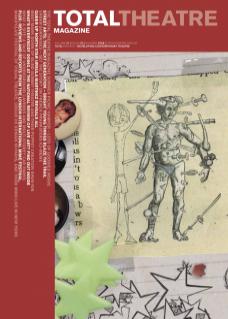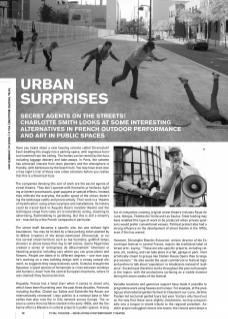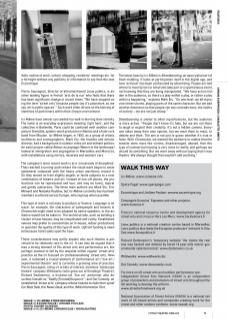Have you heard about a new housing scheme called Chronoclub? Each dwelling fits snugly into a parking space, with ingenious furniture lowered from the ceiling. The homes can be rented by the hour, including luggage delivery and take-aways. In Paris, the scheme has attracted interest from town planners and the atmosphere is friendly, with barbecues by the beach huts. You may have even won a free night’s trial of these new urban solutions before you realise that this is a theatrical hoax.
The companies devising this sort of work are the secret agents of street theatre. They don’t operate with fireworks or fanfares, lighting or lantern processions, giant puppets or special effects. Instead, they infiltrate the everyday, the public space of the street, distorting the landscape subtly and provocatively. Their work is a ‘theatre of mystification’ using urban surprises and installations. Its history could be traced back to Augusto Boal’s invisible theatre and the techniques range from video art to naturalistic acting, clowning to advertising, flashmobbing to gardening. But this is still a minority art – enacted by a few French companies in particular.
The street itself becomes a specific site, but one without tight boundaries. You may be tricked by a fake parking ticket planted by Ici-Même (creators of the above-mentioned Chronoclub), or notice surreal street furniture such as tea fountains, goldfish lamps, showers or phone boxes that ring to tell stories. Opéra Pagaï have created a series of ‘entreprises de détournement’ (diversion or hijacking projects) including cars where you can grow plants and flowers. People are taken in to different degrees – one man says he’s working on a new building design with a strong natural element, so suggests they swap business cards. Kumulus brought the Squames, a spoof species of humanoids (a cross between monkeys and humans), down from the central European mountains, where (it was claimed) they faced extinction.
Arguably, France has a head start when it comes to street arts, which have been flourishing over the past three decades. Festivals including Aurillac, Chalon sur Saône and Sotteville-lès-Rouen are internationally renowned. Lieux publics is a national base in Marseilles that also runs the In Situ network across Europe. The resource centre Hors les Murs started in the early 1990s, and the Sorbonne offers a Masters in cultural projects in public spaces. A long list of companies creating original street theatre includes Royal de Luxe, Ilotopie, Théâtre de l’Unité and Les Goulus. State funding may have enabled this type of work to be produced when private sponsors would prefer conventional venues. Political protest also had a strong influence on the development of street theatre in the 1970s, even if this has waned.
However, Christophe Blandin-Estournet, artistic director of the Excentrique festival in central France, rejects the traditional label of ‘street arts’, saying: ‘These are site-specific projects, including cinema, art, cooking, and can take place in a flat, garage or park. I feel artistically closer to groups like Station House Opera than to large processions.’ He also avoids the usual commercial or festival logic and prefers to talk about ‘population’ or inhabitants instead of ‘audience’. Excentrique therefore works throughout the year with people in the region, with the productions surfacing as a visible moment during the seven weeks of the festival.
Variable locations and generous support have made it possible to programme work using hoaxes and rumour. For example, at the prestigious international garden festival at Chaumont-sur-Loire, Jérôme Poulain led nocturnal guided tours last year. Visitors only found out on the way that these were slightly clandestine, turning unexpectedly into a tongue-in-cheek tribute to the regional president. Another project smuggled clowns into towns: the clowns went about a daily routine of work, school, shopping, residents’ meetings, etc for a fortnight without any publicity or information to say that this was Excentrique.
Pierre Sauvageot, director of aforementioned Lieux publics, is another leading figure in French ‘arts de la rue’ who feels that there has been significant change in recent times. ‘We have stopped using the term “street arts” because people say it’s pejorative, so we say “art in public spaces”.’ Such work often thrives on the blurring of identities of performers within their chosen environment.
Ici-Même have almost succeeded too well in blurring their identity. The name is an everyday expression meaning ‘right here’, and the collective in Belleville, Paris could be confused with another company in Grenoble, spoken-word producers in Nantes and a funk-rock band from Moulon. Ici-Même began, in 1993, as a group of artists, architects and scenographers. Mark Etc, the founder and artistic director, had a background in outdoor video art and militant politics. An early project called Retour au paysage (Return to the landscape) looked at immigration and segregation in Marseilles and Morocco, with installations using mirrors, minarets and western cars.
The company’s more recent work is at a ‘crossroads of disciplines’. They reached a turning-point where the visual work began to seem ephemeral compared with the heavy urban machinery around it. So they moved on from slightly angelic or facile subjects to a new combination of theatre and art. Instead of one-off pieces, the productions can be reproduced and toured, and may be funny, topical and gently subversive. The three main authors are Mark Etc, Eric Ménard and Nataska Roublov, but Ici-Même currently has fourteen members scattered across Europe, who regroup when possible.
This type of work is not easy to produce or finance. Language is an issue: for example, the characters of salespeople and tenants in Chronoclub might need to be adapted by native speakers, or the audience would not be taken in. The technical side, such as building a cluster of new houses, may be complicated and costly. Established venues may prefer to concentrate on in-house, indoor productions or question the quality of this type of work. Upfront funding is needed because ticket sales spoil the hoax.
These considerations may partly explain why such theatre is perceived to be relatively rare in the UK. It can also be argued that it was a strong element of 70s street arts and performance art, but perhaps seemed to fall by the wayside within regular ‘street arts’ practice as the UK focused on ‘professionalising’ street arts. However, it remained a crucial element of ‘performance art / live art / experimental theatre’ and is currently a growing area of practice. Pierre Sauvageot, citing UK artists of interest, mentions ‘landscape theatre’ company Wildworks (who grew out of Kneehigh Theatre); Richard Dedomenici, a trickster-ish ‘live art’ performer who describes himself as ‘Gadfly|Trimtab|Quipnunc’; and Dot Comedy, an established ‘street arts’ company whose hoaxes include their spoof Car Boot Sale, the News Desk, and the (Mis)Information Tent.
The latest hoax by Ici-Même is Streetbooming, an apocryphal sort of flash mobbing. It looks at participation itself in the digital age, and how ‘activism’ has been confiscated by advertising. People are told where to meet by text or email and take part in a spontaneous event, not knowing that they are being manipulated. ‘We have actors hidden in the audience, so there’s a play within a play, or rather a play within a happening,’ explains Mark Etc. ‘On one level, we all improvise street stories, playing parts of the same character. But we add another dimension so that people can see contradictions, the reality of society – we are not just sheep.’
Streetbooming is similar to other mystifications, but the audience is more active. ‘People don’t know it’s fake, but we are not there to laugh or exploit their credulity. It’s not a hidden camera. Everyone takes away their own opinion, but we want them to react, to debate and think. The aim is not just to guess whether it’s true or false. With Chronoclub, we wanted the audience to realise that the tenants were more like victims, disadvantaged, abused, that this type of commercial housing is very close to reality, and perhaps we should do something. But we went away without saying that it was theatre. We always thought that wouldn’t add anything.’
Ici-Même: www.icimeme.info
Opéra Pagaï: www.operapagai.com
Excentrique and Jérôme Poulain: wwww.excentrique.org
Compagnie Kumulus’ Squames and other projects:
www.kumulus.fr
France’s national resource centre and development agency for street arts and circus is Hors Les Murs. www.horslesmurs.fr
Lieux publics is a national creation centre based in Marseilles. Lieux publics also leads the European producers’ network In Situ. See www.lieuxpublics.fr
Richard Dedomenici’s ‘temporary website’ (he claims the real one was hacked and deleted by bored 14 year-olds and/or governmental cyberterrorists): www.dedomenici.co.uk
Wildworks: www.wildworks.biz
Dot Comedy: www.dotcomedy.co.uk
For more on UK street arts and outdoor performance see:
Independent Street Arts Network (ISAN) is an independent group of presenters and promoters of street arts throughout the UK working to develop the artform.
www.streetartsnetwork.org.uk
National Association of Street Artists (NASA) is a national network of UK-based artists and companies creating work for the street and other outdoor contexts. www.nasauk.org


